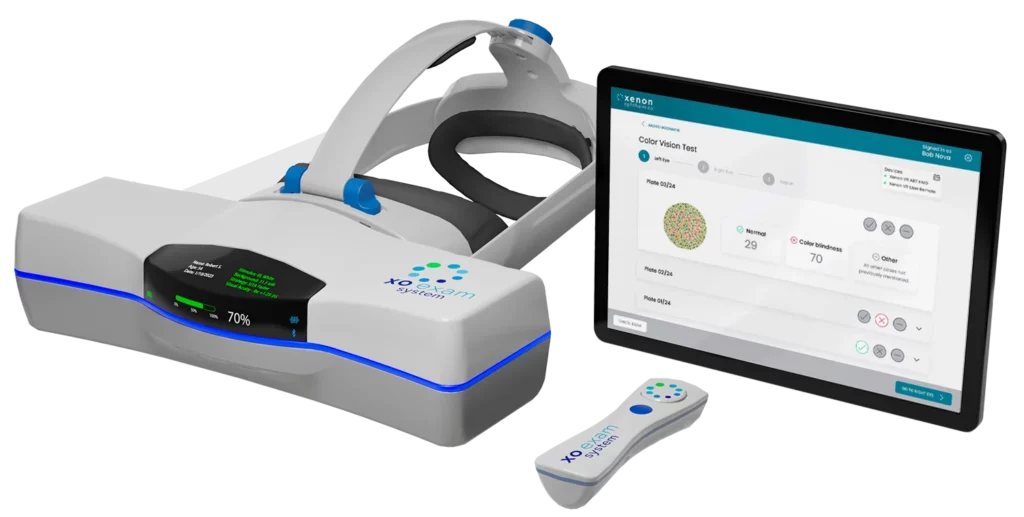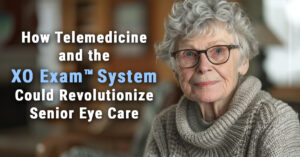The challenge confronting us is not merely a matter of volume; it’s one of complexity and innovation. The increasing prevalence and diversity of vision impairments necessitate a paradigm shift in eye care — from traditional diagnostic and treatment methods to technology-driven solutions that enhance early detection, precise diagnosis, and effective treatment.
The World Health Organization’s (WHO) 2022 report titled ‘Blindness and Vision Impairment‘ paints a startling picture of the situation. It states, “Globally, at least 2.2 billion people have a near or distance vision impairment.
In at least 1 billion – or almost half – of these cases, vision impairment could have been prevented or has yet to be addressed.” These statistics underscore an urgent need to change how we approach vision care. The urgency is not just about meeting escalating demand; it is about pre-empting and addressing preventable vision loss through early detection and intervention.
Myopia has now been labeled the ‘silent epidemic’ and has been increasingly observed in younger generations. This rapid growth in nearsightedness is so stark that projections estimate nearly half of the world’s population will be myopic by 2050. A myopic eye, especially with high myopia, carries a significantly higher risk for serious eye conditions like retinal detachment, glaucoma, and age-related macular degeneration (AMD), potentially leading to severe vision impairment or blindness.
Simultaneously, we face the formidable challenge of age-related eye diseases. As the global population ages, diseases like AMD, cataracts, diabetic retinopathy, and glaucoma are becoming increasingly prevalent. These conditions, if not detected and managed early, can lead to significant vision loss and drastically impact the quality of life of older people.
In the face of these challenges, the need for early detection and effective treatment becomes a common thread weaving together the myriad issues in vision care.
Yet, this is precisely where traditional methods fall short. The limitations of conventional diagnostic tools and methodologies have become starkly evident, emphasizing the pressing need leveragin technology for alternatives.
We are at an interesting junction in the history of eye care. The conventional pathways need to be revised to tackle the rapidly evolving landscape of vision care. The limitations of traditional methodologies in early detection, precise diagnosis, and effective treatment of eye conditions necessitate a paradigm shift. The need of the hour is to leverage technology and innovation to craft solutions that address the roots of the crisis – preventable vision loss and unaddressed vision impairment. We must herald an era where technology and innovation stand at the forefront of vision care, guiding us toward a future where vision impairment is the exception, not the norm.
Embracing Technological Innovation in Vision Care: Leveraging Technology
As we grapple with the increasing demand for vision care, the industry must pivot towards technology for crafting innovative solutions. Emerging technologies such as artificial intelligence (AI), machine learning, telemedicine, and portable diagnostic tools are not just novel add-ons. Instead, they are transformative forces fundamentally rewriting the narrative of global eye care. These tools carry the potential to disrupt conventional eye care methodologies and introduce more effective, efficient, and accessible modes of care.
Artificial Intelligence and Machine Learning: Revolutionizing Diagnostics
AI and machine learning are pushing the boundaries of diagnostics in eye care. Their power lies in swiftly analyzing vast volumes of data, recognizing patterns, and making predictions. With retinal imaging producing large quantities of data, AI can quickly detect abnormalities that may be missed by the human eye, aiding in early detection and diagnosis of conditions such as glaucoma and diabetic retinopathy. Machine learning, a subset of AI, allows computer systems to learn and improve from experience. This technology can predict the progression of diseases based on historical data, enabling personalized treatment plans and improved patient outcomes.
Telemedicine: Bridging the Accessibility Gap
Telemedicine has emerged as a promising solution to enhance access to eye care, particularly in remote and under-resourced regions. Through video conferencing and digital diagnostic tools, practitioners can offer remote consultations and follow-ups, reducing travel time and making eye care more convenient for patients. It also allows for continuous monitoring and early detection of potential issues, reducing the risk of vision impairment.
Portable Diagnostic Tools: Shaping the Future of Eye Care
Meanwhile, portable diagnostic tools are redefining convenience and accessibility in vision care. These compact and user-friendly designs can easily transport these tools to different locations, including patients’ homes, schools, and community centers. For instance, portable ophthalmic diagnostic units incorporating next-generation technologies like aberrometry and visual field examination technology can facilitate comprehensive eye exams outside traditional clinic settings. These innovations make eye care more accessible, reaching populations that were previously hard to serve due to geographical or logistical constraints.
The technological evolution in vision care promises a future where quality eye care is within everyone’s reach. As we navigate the increasing global demand for vision care, leveraging these advancements to create innovative, technology-driven solutions is crucial. Technology is reshaping the tools we use and the very framework of eye care delivery, emphasizing prevention, early detection, personalized treatment, and universal access.
Conclusion: Embracing Technological Advancements for a Healthier Future
As we grapple with the burgeoning demand for eye care due to myopia and age-related eye diseases, there’s a palpable shift from traditional diagnostic and treatment methods toward innovative, technology-driven solutions.
The promise of these advancements by leveraging technology lies in their ability to transform the landscape of global eye care – enhancing accessibility, improving diagnostics, personalizing treatment plans, and, ultimately, preserving vision.
Innovation is no longer a luxury but a necessity in the eye care industry. As practitioners, patients, and stakeholders, we must embrace these technological advancements and foster a culture of continuous innovation. It’s a challenging path but also one teeming with opportunities to improve lives by protecting vision. Let’s collectively step forward into this new era of eye care, confident that innovative solutions answer the world’s eye care dilemma.
Next-Generation Medical Grade Ophthalmic Diagnostics
Xenon Ophthalmics™ is on a mission to transform how eye care is delivered around the globe. Our XO Exam™ system of interchangeable, wearable ophthalmic diagnostic units offers next-generation aberrometry (XO Exam™ ABT) and visual field (XO Exam™ VFT) examinations to increase access to eye care.
Our XO Exam™ system is the only medical-grade technology to meet the increasing global demand for eye care and the Eye Care Professionals’ ability to meet that demand with the highest level of patient care and practice growth potential.
A Comprehensive Approach to Providing Greater Access to Vision Care While Increasing the Quality of the Care Provided

XO Exam™ System
The XO Exam™ System includes diagnostic features of traditional ophthalmic devices like phoropters, autorefractors, and visual field units.



